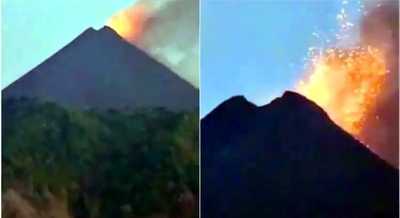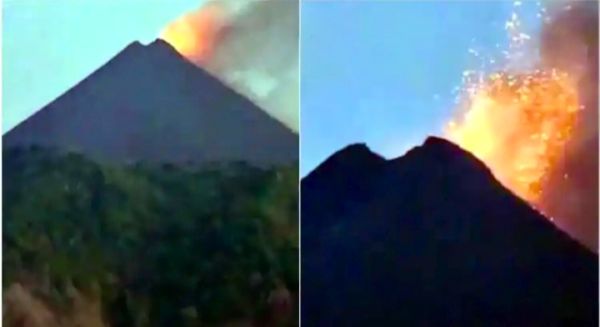

Sri Vijaya Puram: Scientists are closely monitoring the eruption of India’s only active volcano on Barren Island in the Andaman and Nicobar Islands. This is the second eruption within a week. While experts have called the eruption ‘minor’, they are trying to understand what triggered it.
Barren Island, as the name suggests, is uninhabited. Hence there is no threat to life or property. The Indian Navy, which recorded the event, has issued a warning to other vessels to avoid the area.
The video recorded by a Navy warship shows spectacular flows of red-hot lava racing down the slopes while thick smoke streams poured from the summit. This has stirred widespread interest and scientific scrutiny.
“Barren Island’s volcanic activity is rooted in its geology, specifically, the dynamics between the Indo-Australian and Eurasian (Sunda) tectonic plates. The Andaman-Nicobar arc is a classic subduction zone, where the Indian plate slips beneath the Sundic plate and into the mantle, triggering earthquakes and providing pathways for magma to rise,” an expert said.
This process makes the region highly seismically and volcanically active, with frequent micro-seismic events and sometimes stronger tremors that can disturb magmatic chambers within the volcano itself. Geologists believe that the recent shaking and minor explosion at Barren Island were triggered by increased seismic activity in the magma chamber below the volcano.
The archipelago is known for continuous earthquakes ranging from mild microseismicity to moderate ones, which can rupture rocks in and around the magma reservoir. When these quakes occur, they can release pressure and permit magma and volcanic gases to escape through fractures towards the surface, resulting in explosive activity and the dramatic scenes observed.
Barren Island is roughly 3.2 km wide and rises nearly 2 km above the surrounding seabed, with its main summit about 300-354 meters above sea level.
After remaining dormant for nearly 150 years, it erupted in 1991 and experienced phases of renewed activity between 2017 and 2019. Teams from the National Centre for Seismology and the Geological Survey of India are analysing data and new imagery to assess the eruption’s scale and future risk.
-
Good Morning Britain issues 'catastrophic' breaking news update

-
Self-styled godman booked for sexually harassing students at Delhi management institute

-
Migrant criminals on deportation flights given £2,000 on cash cards no questions asked

-
Maharashtra's Deputy CM Urges Immediate Aid for Farmers Affected by Heavy Rains
-
Art is means of enriching cultural heritage, making society more sensitive: President Murmu
